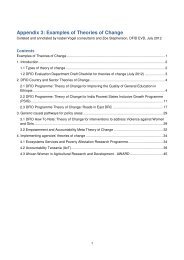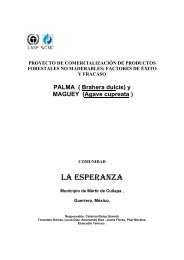Full Report - Research for Development - Department for ...
Full Report - Research for Development - Department for ...
Full Report - Research for Development - Department for ...
You also want an ePaper? Increase the reach of your titles
YUMPU automatically turns print PDFs into web optimized ePapers that Google loves.
Nahar (2004)<br />
(-)/(-)<br />
Tukur (2007)<br />
(+)/(-)<br />
Women with<br />
eclampsia or preeclampsia<br />
Women with<br />
antepartum<br />
eclampsia<br />
Micronutrient supplementation<br />
Fawzi (2007)<br />
(++)/(++)<br />
HIV-negative<br />
pregnant women<br />
Misoprostol in severe pre-eclampsia (group<br />
1) and eclampsia patients(group 2) with<br />
unripe cervix. 50mg of misoprostol was<br />
used every 4 hours in cases of unripe cervix<br />
(Bishop score < or = 6). Magnesium sulphate<br />
was used routinely <strong>for</strong> patients with<br />
eclampsia.<br />
Misoprostol. If the patient did not go into<br />
labour within four hours of inserting<br />
misoprostol, the induction was considered<br />
to have failed and emergency CS offered.<br />
CS was also offered if any other<br />
complication that warranted a CS such as<br />
foetal distress arose.<br />
Daily multivitamins vs placebo (all women<br />
received iron and folic acid supplements).<br />
Maternal<br />
mortality<br />
Perinatal<br />
mortality<br />
Maternal<br />
mortality<br />
Perinatal<br />
mortality<br />
Perinatal<br />
mortality<br />
Neonatal<br />
mortality<br />
Appendix 4.1<br />
The groups were compared to each<br />
other but no control so impact on<br />
mortality not clear. No maternal deaths<br />
recorded. Neonatal deaths were 11% in<br />
severe pre-eclampsia group and 12% in<br />
eclampsia group. Study concludes that<br />
intravaginal misoprostol is well<br />
tolerated and very effective <strong>for</strong> the<br />
induction of labour in severe preeclampsia<br />
and eclampsia patients with<br />
unripe cervix.<br />
There were more maternal<br />
complications and admissions of babies<br />
into the neonatal special care unit<br />
(NSCU) in the CS group compared to<br />
misoprostol group. Maternal mortality in<br />
the two groups was similar (2% each).<br />
HIV-negative Tanzanian women who<br />
received prenatal supplementation with<br />
vitamin B complex and vitamins C and E<br />
did not have significantly reduced risks<br />
of prematurity and foetal death, but<br />
they did have significantly reduced risk<br />
of LBW.<br />
What are the effects of different models of delivery <strong>for</strong> improving maternal and infant health outcomes <strong>for</strong> poor people in urban areas in low income<br />
and lower middle income countries?<br />
199









